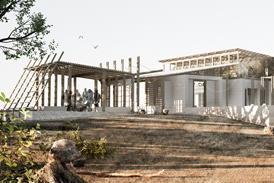- Home
- Intelligence for Architects
- Subscribe
- Jobs
- Events

2025 events calendar Explore now 
Keep up to date
Find out more
- Programmes
- CPD
- More from navigation items
In pictures: WongAvery Gallery, Cambridge, by Níall McLaughlin Architects

Cruciform practice and performance pavilion overcomes planning and construction hurdles
Níall McLaughlin Architects was presented with a range of planning and construction hurdles after it was commissioned to deliver the WongAvery Music Gallery for Cambridge University’s Trinity Hall.
But the practice rose to the challenge of slotting a new building providing practice and performance space into the college’s Avery Court, which is surrounded by grade I and grade II-listed buildings, including the chapels of Trinity Hall and Clare College.
In addition to displaying appropriate reverence to its listed neighbours, the new pavilion needed to ensure that light levels for windows facing the court were maintained. The scheme also had to be buildable with access exclusively via a narrow pedestrian passageway.
…
This content is available to registered users | Already registered?Login here
You are not currently logged in.
To continue reading this story, sign up for free guest access
Existing Subscriber? LOGIN
REGISTER for free access on selected stories and sign up for email alerts. You get:
- Up to the minute architecture news from around the UK
- Breaking, daily and weekly e-newsletters
Subscribe to Building Design and you will benefit from:

- Unlimited news
- Reviews of the latest buildings from all corners of the world
- Technical studies
- Full access to all our online archives
- PLUS you will receive a digital copy of WA100 worth over £45
Subscribe now for unlimited access.






